In the bustling world of today, who doesn’t dream of a life meticulously crafted to their liking? Enter the realm of lifestyle design, a fascinating concept that’s transforming the way we live and work. This revolutionary approach encourages individuals to break free from traditional societal norms and design a life that aligns with their personal goals and passions.
Lifestyle design isn’t merely about living lavishly; it’s about creating a meaningful existence that brings joy, satisfaction, and balance. Whether you’re an aspiring lifestyle designer or just curious about this intriguing concept, this article will shed light on the ins and outs of lifestyle design. Stay tuned as we delve into the strategies, benefits, and real-life examples that illustrate the power of lifestyle design.
Lifestyle Designer
Delving deeper into the intricate construct of lifestyle design, it’s pivotal to examine the responsibilities of a lifestyle designer and trace the footsteps of this concept’s origin and evolution.
Role of a Lifestyle Designer
A lifestyle designer functions as an architect for one’s life, sketching the blueprints for a tailored existence. This role concentrates on defining life standards and shaping daily practices based on individual aspirations, dreams, and values. Notably, a lifestyle designer doesn’t impose pre-existing societal norms or traditional paths instead, they tweak the conventional system for a personal fit.
For instance, a lifestyle designer could focus on creating a work schedule that encourages remote employment, allowing more time for personal pursuits, traveling, or family. In this way, the lifestyle designer refines an individual’s existing life landscapes into a more personalized and fulfilling experience.
 The Pros and Cons of Being a Lifestyle Designer
The Pros and Cons of Being a Lifestyle Designer
A lifestyle designer experiences a unique set of benefits and drawbacks, influenced largely by their personal values, abilities, and circumstances. This section breaks down the various advantages and challenges inherent in adopting this alternative life path.
Exploring the Advantages
Becoming a lifestyle designer presents several tangible rewards. Freedom, a key selling point, forms the cornerstone. A lifestyle designer gains immense personal and professional freedom to sculpt their existence based on their preferences. Secondly, they acquire flexibility, evident in their ability to adjust their routines and environments to match their requirements. Flexibility rarely seen in conventional careers or lifestyles. Additionally, lifestyle designers get to experience personal growth. Utilizing opportunities for self-improvement, they gain new skills, knowledge, and insight into different cultures and societies when choosing a dynamic or travel-inclined lifestyle.
Regardless of the pathways chosen, lifestyle designers potentially reap advantages like job satisfaction and overall happiness. Individuals like Tim Ferriss and Courtney Carver, mentioned previously, underscore the transformative effect of lifestyle design. Their journeys capture the possibilities of increased productivity, personal fulfillment, stress reduction, and improved well-being.
Addressing the Disadvantages
Despite the alluring benefits, lifestyle design isn’t void of challenges. For starters, uncertainty presents a substantial issue. Without the stability of a traditional job, lifestyle designers can struggle with fluctuations in income or perceive a lack of a clear career path.
Similarly, they may experience isolation. Especially if their chosen lifestyle involves extensive travel or unconventional work hours, this could hinder opportunities for establishing and maintaining relationships. Moreover, lifestyle design involves constant self-management and motivation. Individuals must consistently adjust and reassess their goals and strategies, which can be tiring and overwhelming.
Finally, balancing personal and professional demands in a personalized lifestyle landscape presents an issue. Lifestyle designers like Tim Ferriss have mastered task optimization and remote work, yet not every lifestyle designer may find such a balance achievable or fulfilling. Hence, it’s important for aspiring lifestyle designers to understand these potential challenges to make informed choices.
 Final Thoughts
Final Thoughts
Embracing lifestyle design can indeed be a game-changer. It’s about taking control, breaking free from societal norms, and crafting a life that aligns with personal values and aspirations. It’s not just about luxury; it’s about achieving a fulfilling, balanced existence. As a lifestyle designer, one becomes the architect of their life, shaping daily practices based on individual goals. The skills needed – critical thinking, creativity, resilience, digital literacy – are all instrumental in making this possible. Despite the challenges, such as income instability and the need for constant self-management, the rewards can be substantial. From personal and professional freedom to opportunities for personal growth, lifestyle design can lead to increased job satisfaction and overall happiness. The journeys of Tim Ferriss and Courtney Carver serve as inspiring examples of the transformative power of lifestyle design. So, it’s worth considering: could you be the next successful lifestyle designer?